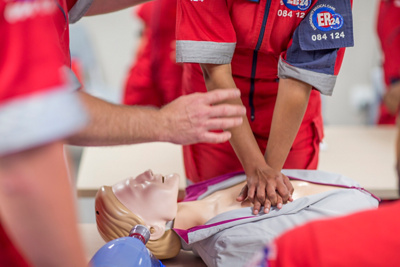Cardiac arrest occurs when someone’s heart suddenly stops beating, leading to loss of breathing and unconsciousness.
The most common cause is a heart attack, explains Tao Carstens, Branch Manager for ER24 Southern Cape, but there are many other reasons for cardiac arrest, including heart disease, stroke, electrocution, drowning and suffocation. It can also occur when a patient has a seizure and stops breathing. Patients experiencing cardiac arrest are usually unresponsive, show no signs of a pulse and aren’t breathing. “When it comes to assisting the patient, we say time is (heart) muscle,” Tao says. “For every minute the person doesn’t receive medical intervention or CPR, there’s a 10% decrease in their chance of survival.
Don't wait to start CPR
Waiting too long to start CPR can significantly decrease the odds of that person surviving. It’s crucial to get pre-hospital emergency assistance as soon as possible and bystanders should start CPR before the ER24 paramedics get there.” Always call ER24 on 084 124 for immediate assistance in the event of cardiac arrest. “Then lie the person on their back, feel for a pulse and start CPR immediately,” Tao says. “The ER24 Contact Centre will guide you telephonically – and if you’re in a public place that has a portable automated external defibrillator (AED) on hand, they’ll get security to bring the AED. Remember, every second counts.”
Once an ambulance and Advanced Life Support team have been dispatched, the Contact Centre stays on the phone with the caller to help them perform CPR. “Bystanders should start with telephonic-assisted CPR in order to buy time before we get there,” Tao adds. Once ER24 arrives, a number of things will happen simultaneously.
Firstly, an ER24 paramedic will take over CPR and chest compressions. “We then attach an AED, which can check a person's heart rhythm and deliver electric shock to restore a normal heartbeat.” An AED is most effective if used within five minutes of the person collapsing. Most offices, schools, shopping centres, airports and other public places should have one. “Once the AED is attached, it tells us if the person has a shockable heart rhythm, or non-shockable heart rhythm. Ventricular tachycardia (VT or V-tach) and ventricular fibrillation (VF or V-fib) are both shockable rhythms. The two non-shockable rhythms are pulseless electrical activity (PEA) and asystole. “If the AED shows the rhythm is non-shockable, we’ll continue with CPR. At the same time, someone is preparing an intravenous (IV) line, so we can give medication through the drip to restart the heart.
Adrenaline is the most common chemical jumpstart we use to get the heart to beat on its own.” Tao adds that if the AED shows the patient has a shockable rhythm, ER24 paramedics will use the AED before administering a membrane stabiliser to get the heart beating on its own again. “Patients in cardiac arrest are unable to breathe adequately for themselves, so we also establish an advanced airway in order to take over breathing for them. We give them medical oxygen (100% oxygen) because if the brain is without oxygen for too long, then brain death occurs.” Tao explains that the ER24 first responder team will then fall into rotation. “Every two minutes we check for a pulse, reassess, swap out the rescuers in order to give the person who is doing chest compressions a rest, and then continue.”
Call for an ambulance by dialing 084124


